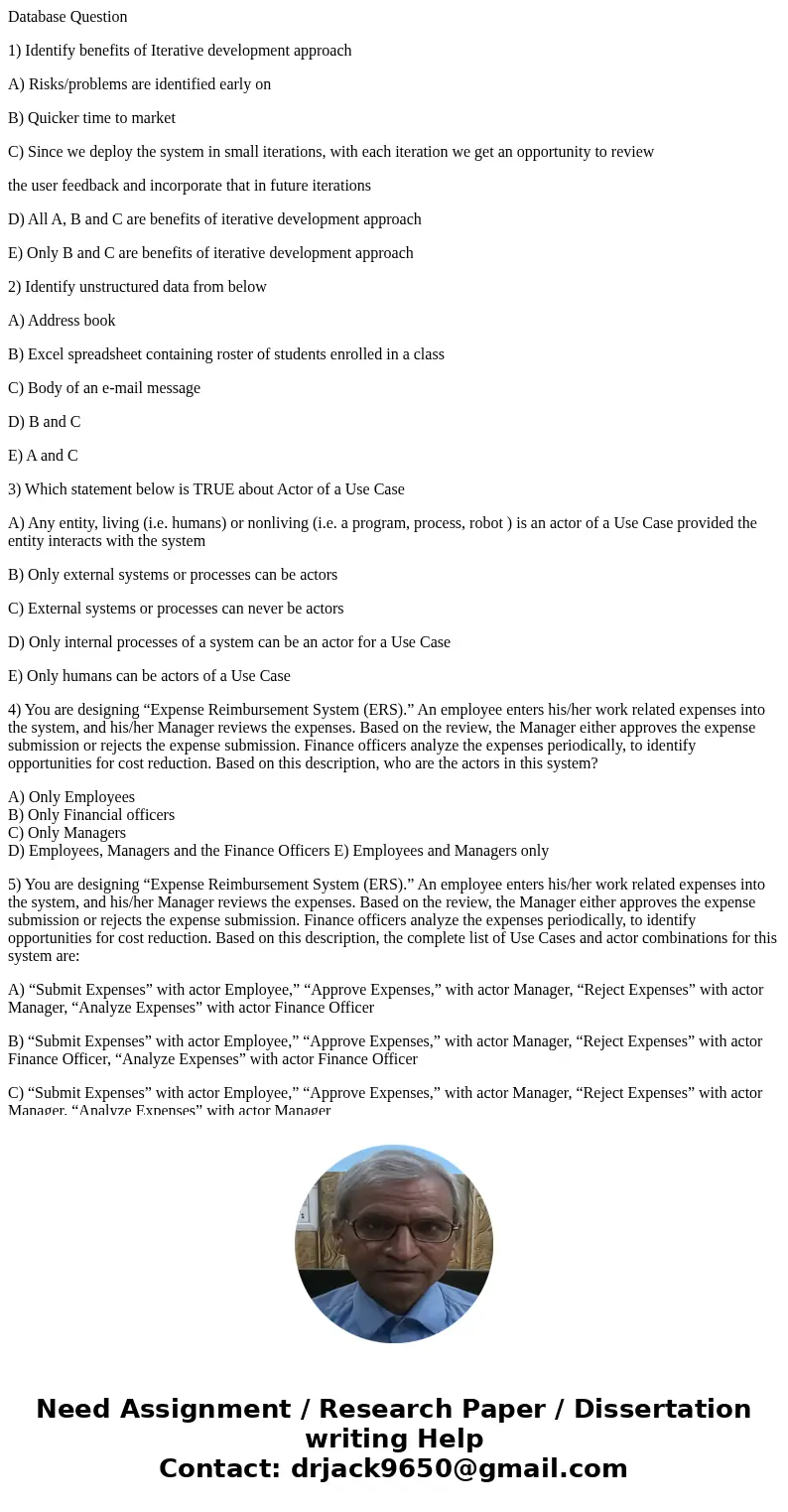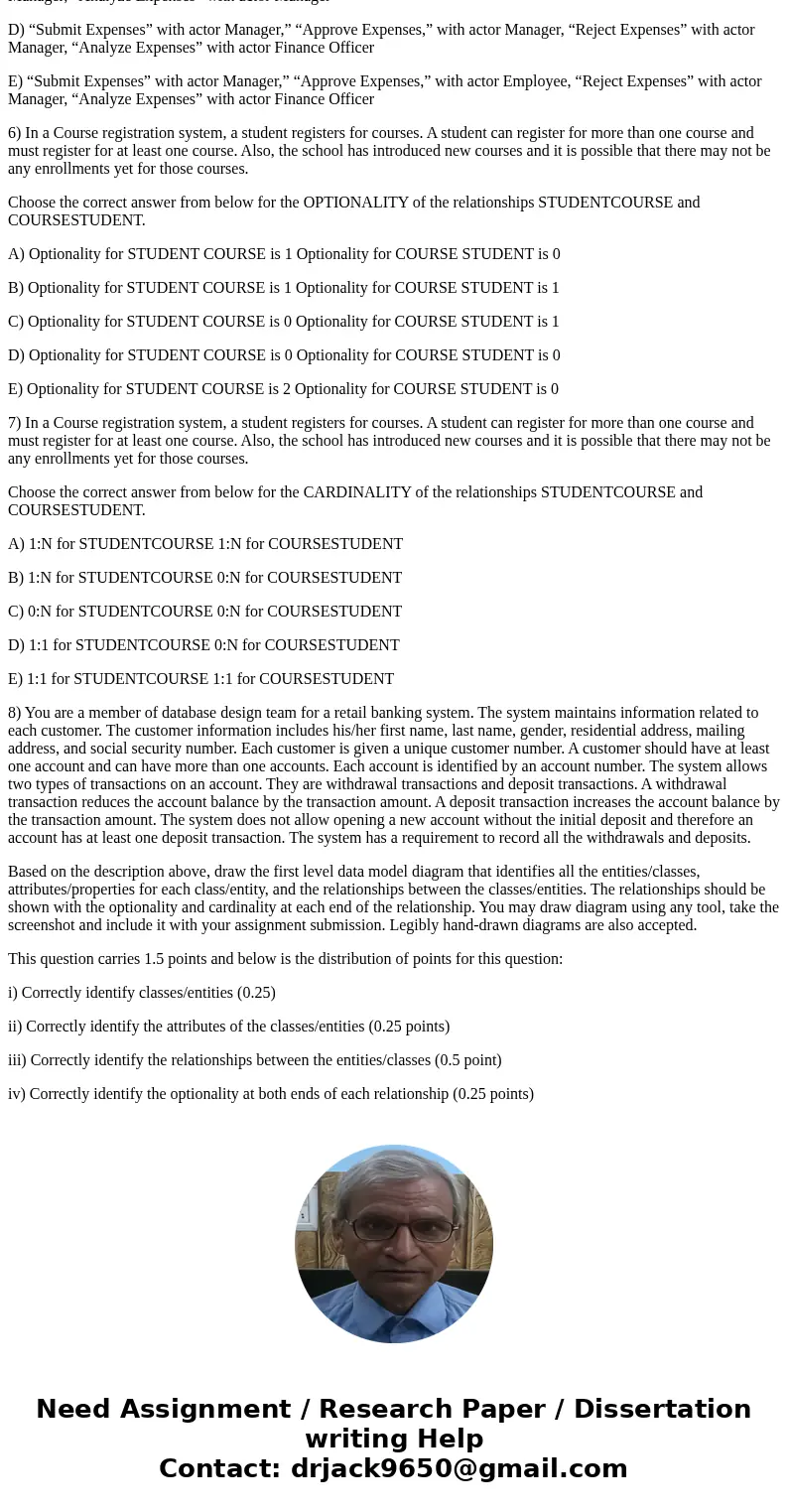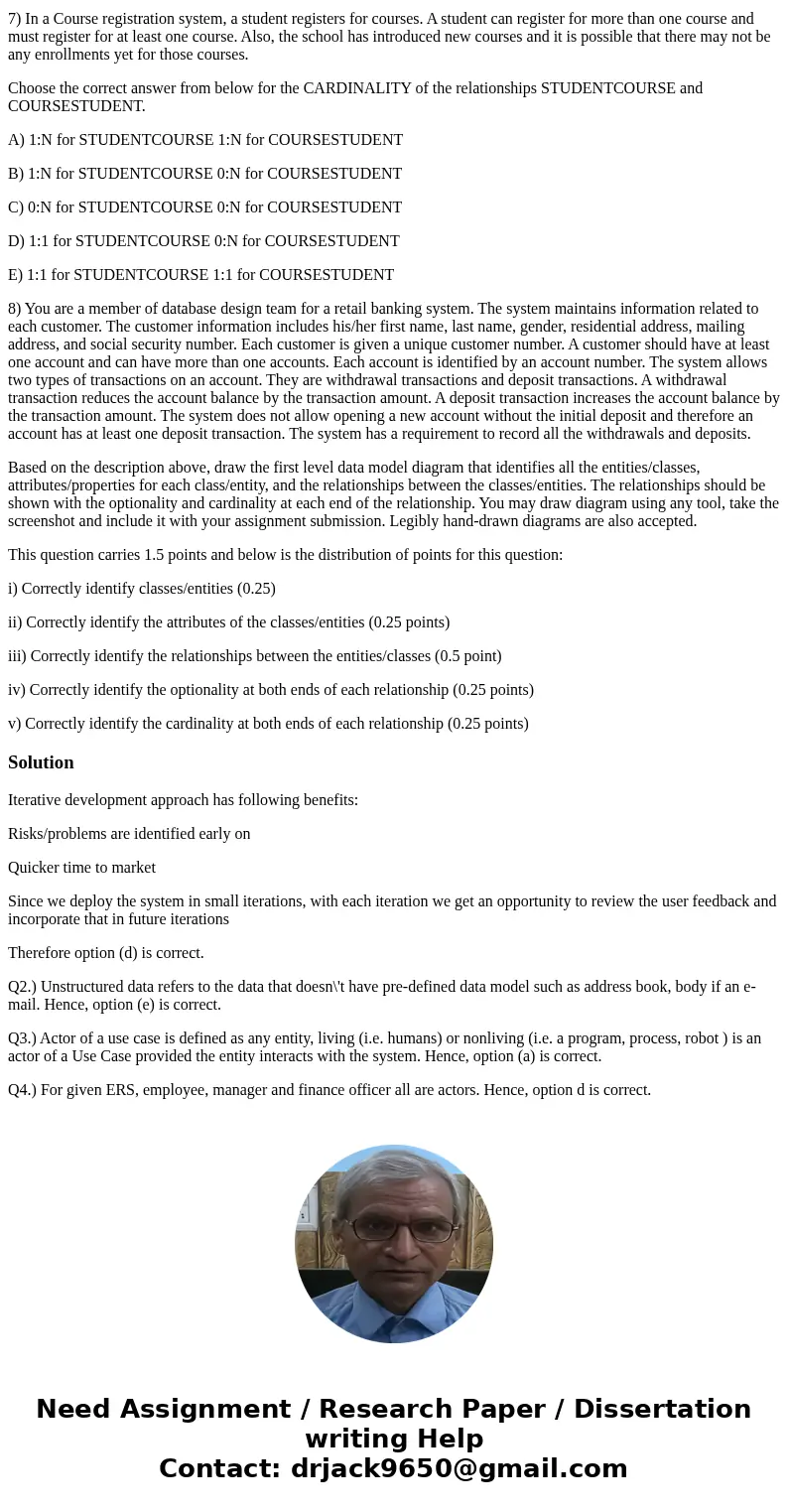Database Question 1 Identify benefits of Iterative developme
Database Question
1) Identify benefits of Iterative development approach
A) Risks/problems are identified early on
B) Quicker time to market
C) Since we deploy the system in small iterations, with each iteration we get an opportunity to review
the user feedback and incorporate that in future iterations
D) All A, B and C are benefits of iterative development approach
E) Only B and C are benefits of iterative development approach
2) Identify unstructured data from below
A) Address book
B) Excel spreadsheet containing roster of students enrolled in a class
C) Body of an e-mail message
D) B and C
E) A and C
3) Which statement below is TRUE about Actor of a Use Case
A) Any entity, living (i.e. humans) or nonliving (i.e. a program, process, robot ) is an actor of a Use Case provided the entity interacts with the system
B) Only external systems or processes can be actors
C) External systems or processes can never be actors
D) Only internal processes of a system can be an actor for a Use Case
E) Only humans can be actors of a Use Case
4) You are designing “Expense Reimbursement System (ERS).” An employee enters his/her work related expenses into the system, and his/her Manager reviews the expenses. Based on the review, the Manager either approves the expense submission or rejects the expense submission. Finance officers analyze the expenses periodically, to identify opportunities for cost reduction. Based on this description, who are the actors in this system?
A) Only Employees
B) Only Financial officers
C) Only Managers
D) Employees, Managers and the Finance Officers E) Employees and Managers only
5) You are designing “Expense Reimbursement System (ERS).” An employee enters his/her work related expenses into the system, and his/her Manager reviews the expenses. Based on the review, the Manager either approves the expense submission or rejects the expense submission. Finance officers analyze the expenses periodically, to identify opportunities for cost reduction. Based on this description, the complete list of Use Cases and actor combinations for this system are:
A) “Submit Expenses” with actor Employee,” “Approve Expenses,” with actor Manager, “Reject Expenses” with actor Manager, “Analyze Expenses” with actor Finance Officer
B) “Submit Expenses” with actor Employee,” “Approve Expenses,” with actor Manager, “Reject Expenses” with actor Finance Officer, “Analyze Expenses” with actor Finance Officer
C) “Submit Expenses” with actor Employee,” “Approve Expenses,” with actor Manager, “Reject Expenses” with actor Manager, “Analyze Expenses” with actor Manager
D) “Submit Expenses” with actor Manager,” “Approve Expenses,” with actor Manager, “Reject Expenses” with actor Manager, “Analyze Expenses” with actor Finance Officer
E) “Submit Expenses” with actor Manager,” “Approve Expenses,” with actor Employee, “Reject Expenses” with actor Manager, “Analyze Expenses” with actor Finance Officer
6) In a Course registration system, a student registers for courses. A student can register for more than one course and must register for at least one course. Also, the school has introduced new courses and it is possible that there may not be any enrollments yet for those courses.
Choose the correct answer from below for the OPTIONALITY of the relationships STUDENTCOURSE and COURSESTUDENT.
A) Optionality for STUDENT COURSE is 1 Optionality for COURSE STUDENT is 0
B) Optionality for STUDENT COURSE is 1 Optionality for COURSE STUDENT is 1
C) Optionality for STUDENT COURSE is 0 Optionality for COURSE STUDENT is 1
D) Optionality for STUDENT COURSE is 0 Optionality for COURSE STUDENT is 0
E) Optionality for STUDENT COURSE is 2 Optionality for COURSE STUDENT is 0
7) In a Course registration system, a student registers for courses. A student can register for more than one course and must register for at least one course. Also, the school has introduced new courses and it is possible that there may not be any enrollments yet for those courses.
Choose the correct answer from below for the CARDINALITY of the relationships STUDENTCOURSE and COURSESTUDENT.
A) 1:N for STUDENTCOURSE 1:N for COURSESTUDENT
B) 1:N for STUDENTCOURSE 0:N for COURSESTUDENT
C) 0:N for STUDENTCOURSE 0:N for COURSESTUDENT
D) 1:1 for STUDENTCOURSE 0:N for COURSESTUDENT
E) 1:1 for STUDENTCOURSE 1:1 for COURSESTUDENT
8) You are a member of database design team for a retail banking system. The system maintains information related to each customer. The customer information includes his/her first name, last name, gender, residential address, mailing address, and social security number. Each customer is given a unique customer number. A customer should have at least one account and can have more than one accounts. Each account is identified by an account number. The system allows two types of transactions on an account. They are withdrawal transactions and deposit transactions. A withdrawal transaction reduces the account balance by the transaction amount. A deposit transaction increases the account balance by the transaction amount. The system does not allow opening a new account without the initial deposit and therefore an account has at least one deposit transaction. The system has a requirement to record all the withdrawals and deposits.
Based on the description above, draw the first level data model diagram that identifies all the entities/classes, attributes/properties for each class/entity, and the relationships between the classes/entities. The relationships should be shown with the optionality and cardinality at each end of the relationship. You may draw diagram using any tool, take the screenshot and include it with your assignment submission. Legibly hand-drawn diagrams are also accepted.
This question carries 1.5 points and below is the distribution of points for this question:
i) Correctly identify classes/entities (0.25)
ii) Correctly identify the attributes of the classes/entities (0.25 points)
iii) Correctly identify the relationships between the entities/classes (0.5 point)
iv) Correctly identify the optionality at both ends of each relationship (0.25 points)
v) Correctly identify the cardinality at both ends of each relationship (0.25 points)
Solution
Iterative development approach has following benefits:
Risks/problems are identified early on
Quicker time to market
Since we deploy the system in small iterations, with each iteration we get an opportunity to review the user feedback and incorporate that in future iterations
Therefore option (d) is correct.
Q2.) Unstructured data refers to the data that doesn\'t have pre-defined data model such as address book, body if an e-mail. Hence, option (e) is correct.
Q3.) Actor of a use case is defined as any entity, living (i.e. humans) or nonliving (i.e. a program, process, robot ) is an actor of a Use Case provided the entity interacts with the system. Hence, option (a) is correct.
Q4.) For given ERS, employee, manager and finance officer all are actors. Hence, option d is correct.



 Homework Sourse
Homework Sourse